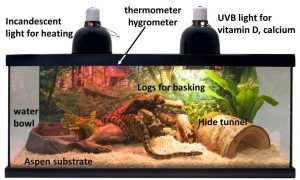
Determine the age of your pet reptile and amphibian before making your purchase. Many animals are sold as hatchlings, but the first-time pet owner may be better off with an older juvenile or even a young adult – although these may cost more, they are typically hardier specimens that are less susceptible to illness.
Consider the enclosure and habitat requirements for your pet. Generally, frogs or salamanders require smaller enclosures that will fit within most rooms, whereas some king snakes may reach six feet in length and require a much larger tank. Some turtles and tortoises do best in outdoor environments, requiring more space and maintenance to secure the enclosure and prevent escape by burrowing or climbing species. Also, consider that the size of the enclosure will grow with the pet: a juvenile milk snake may thrive in a 10-gallon terrarium but an adult will need a spacious 55-gallon tank. Many herps will be the only occupant of their habitats, but enclosures with several individuals or more than one species (such as aquatic turtles) must be larger.
Each species has its own ideal temperature and humidity, reflecting its natural habitat. For example, a poison dart frog native to South American tropical rainforest needs a daytime temperature of around 80oF and relative humidity between 80-100%; a Russian tortoise, adapted to arid areas in Afghanistan with extreme temperatures, will do well with temperatures closer to 70oF and 40-60% relative humidity. Some herps need a temperature gradient, where species can bask to warm up or retreat to shelter to cool off.
As it is with any pet, properly handling a reptile or amphibian is important for your pet’s health and your own. Although comfortable in captivity, herps are still wildlife that retain their natural instincts. Snakes occasionally bite, most often during handling or feeding. Some herps, like fire-bellied toads, release mild toxins that can irritate the eyes and skin. Most reptiles may harbor bacteria that can lead to illness in humans. These incidents can generally be avoided with careful handling:
- Learn your pet’s behavior and response to routine activities such as feeding and cleaning its enclosure.
- Wash your hands thoroughly with soap and water after handling your pet.
- Avoid unsupervised handling by anyone unfamiliar with your pet.